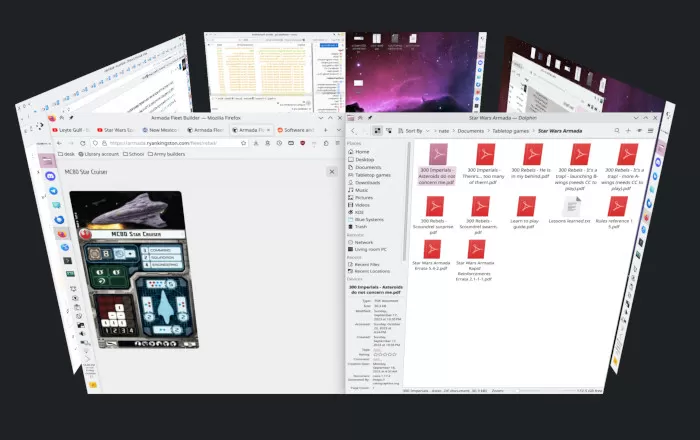Well known KDE developer Nate Graham is out with a blog post today outlining his latest Wayland thoughts, how X11 is a bad platform, and the recent topic of “Wayland breaking everything” isn’t really accurate.
“In this context, “breaking everything” is another perhaps less accurate way of saying “not everything is fully ported yet”. This porting is necessary because Wayland is designed to target a future that doesn’t include 100% drop-in compatibility with everything we did in the past, because it turns out that a lot of those things don’t make sense anymore. For the ones that do, a compatibility layer (XWayland) is already provided, and anything needing deeper system integration generally has a path forward (Portals and Wayland protocols and PipeWire) or is being actively worked on. It’s all happening!”
Alternatively, instead of reading a Phoronix article that has a couple of short snippets from a much longer blog post, you can read the original blog post yourself to see the full context.
Edit: Also, it is worth noting that the author of the original blog post had previously written another relatively recent post criticizing the way in which Wayland was developed, so it’s not like they are refusing to see its problems.
One of the specific issues from those who’ve worked with Wayland and is echoed here in Nate’s other post that you mentioned.
Wayland has not been without its problems, it’s true. Because it was invented by shell-shocked X developers, in my opinion it went too far in the other direction.
I tend to disagree. Had say the XDG stuff been specified in protocol, implementation of handlers for some of that XDG stuff would have been required in things that honestly wouldn’t have needed them. I don’t think infotainment systems need a concept of copy/paste but having to write:
Some_Sort_Of_Return handle_copy(wl_surface *srf, wl_buffer* buf) { //Completely ignore this return 0; } Some_Sort_Of_Return handle_paste(wl_surface *srf, wl_buffer* buf) { //Completely ignore this return 0; }Is really missing the point of starting fresh, is bytes in the binary that didn’t need to be there, and while my example is pretty minimal for shits and giggles IRL would have been a great way to introduce “randomness” and “breakage” for those just wanting to ignore this entire aspect.
But one of those agree to disagree. I think the level of hands off Wayland went was the correct amount. And now that we have things like
wlrootseven better, because if want to start there you can now start there and add what you need. XDG is XDG and if that’s what you want, you can have it. But if you want your own way (because eff working nicely with GNOME and KDE, if that’s your cup of tea) you’ve got all the rope in the world you will ever need.I get what Nate is saying, but things like XDG are just what happened with ICCCM. And when Wayland came in super lightweight, it allowed the inevitably of XDG to have lots of room to specify. ICCCM had to contort to fit around X. I don’t know, but the way I like to think about it is like unsalted butter. Yes, my potato is likely going to need salt and butter. But I like unsalted butter because then if I want a pretty light salt potato, I’m not stuck with starting from salted butter’s level of salt.
I don’t know, maybe I’m just weird like that.
I don’t think infotainment systems need a concept of copy/paste but having to write:
Having lived through the whole “phones don’t need copy and paste debate”, which fortunately got solved by now having it everywhere I’m in the camp “just stick that everywhere, just in case somebody might use it one day”
Over on Nate’s other blog entry he indicates this:
The fundamental X11 development model was to have a heavyweight window server–called Xorg–which would handle everything, and everyone would use it. Well, in theory there could be others, and at various points in time there were, but in practice writing a new one that isn’t a fork of an old one is nearly impossible
And I think this is something people tend to forget. X11 as a protocol is complex and writing an implementation of it is difficult to say the least. Because of this, we’ve all kind of relied on Xorg’s implementation of it and things like KDE and GNOME piggyback on top of that. However, nothing (outside of the pure complexity) prevented KWin (just as an example) implementing it’s own X server. KWin having it’s own X server would give it specific things that would better handle the things KWin specifically needed.
Good parallel is how crazy insane the HTML5 spec has become and how now pretty much only Google can write a browser for that spec (with thankfully Firefox also keeping up) and everyone is just cloning that browser and putting their specific spin to it. But if a deep enough core change happens, that’s likely to find its way into all of the spins. And that was some of the issue with X. Good example here, because of the specific way X works an “OK” button (as an example) is actually implemented by your toolkit as a child window. Menus those are windows too. In fact pretty much no toolkit uses primitives anymore. It’s all windows with lots and lots of text attributes. And your toolkit Qt, Gtk, WINGs, EFL, etc handle all those attributes so that events like “clicking a mouse button” work like had you clicked a button and not a window that’s drawn to look like a button.
That’s all because these toolkits want to do things that X won’t explicitly allow them to do. Now the various DEs can just write an X server that has their concept of what a button should do, how it should look, etc… And that would work except that, say you fire up GIMP that uses Gtk and Gtk has it’s idea of how that widget should look and work and boom things break with the KDE X server. That’s because of the way X11 is defined. There’s this middle man that always sits there dictating how things work. Clients draw to you, not to the screen in X. And that’s fundamentally how X and Wayland are different.
I think people think of Wayland in the same way of X11. That there’s this Xorg that exists and we’ll all be using it and configuring it. And that’s not wholly true. In X we have the X server and in that department we had Xorg/XFree86 (and some other minor bit players). The analog for that in Wayland (roughly, because Wayland ≠ X) is the Compositor. Of which we have Mutter, Clayland, KWin, Weston, Enlightenment, and so on. Which that’s more than just one that we’re used to. That’s because the Wayland protocol is simple enough for these multiple implementations.
The skinny is that a Compositor needs to at the very least provide these:
- wl_display - This is the protocol itself.
- wl_registry - A place to register objects that come into the compositor.
- wl_surface - A place for things to draw.
- wl_buffer - When those things draw there should be one of these for them to pack the data into.
- wl_output - Where rubber hits the road pretty much, wl_surface should display wl_buffer onto this thing.
- wl_keyboard/wl_touch/etc - The things that will interact with the other things.
- wl_seat - The bringing together of the above into something a human being is interacting with.
And that’s about it. The specifics of how to interface with hardware and what not is mostly left to the kernel. In fact, pretty much compositors are just doing everything in EGL, that is KWin’s wl_buffer (just random example here) is a
eglCreatePbufferSurfacewith other stuff specific to what KWin needs and that’s it. I would assume Mutter is pretty much the same case here. This gets a ton of the formality stuff that X11 required out of the way and allows Compositors more direct access to the underlying hardware. Which was pretty much the case for all of the Window Managers since 2010ish. All of them basically Window Manage in OpenGL because OpenGL allowed them to skip a lot of X, but of course there is GLX (that one bit where X and OpenGL cross) but that’s so much better than dealing with Xlib and everything it requires that would routinely require “creative” workarounds.This is what’s great about Wayland, it allows KWin to focus on what KWin needs, mutter to focus on what mutter needs, but provides enough generic interface that Qt applications will show up on mutter just fine. Wayland goes out of its way to get out of the way. BUT that means things we’ve enjoyed previously aren’t there, like clipboards, screen recording, etc. Because X dictated those things and for Wayland, that’s outside of scope.
The fundamental X11 development model was to have a heavyweight window server–called Xorg–which would handle everything, and everyone would use it.
So there’s a Wayland hope for systemd-afflicted boxes and their cults.
You anti-systemd folks are so insufferable.
That’s my problem with this. It tries to be a desktop display server protocol without unifying all desktop requirements. Sure, X11 is old and have unnecessary things that aren’t relevant anymore, however, as someone who builds their own DE, (e.g.: tiling window managers) I see it as the end of this masterrace. Unless everybody moves to wlroots. Flameshot, for example, is already dealing with this, having at least 5 implementations only for linux, and only wlroots and x11 are standards.
Also, imo, having windows in windows is useful when you want to use your favourite terminal in your favourite IDE. But as you said DEs can implement it simply. Let’s say wlroots will implement this but others can decide otherwise. And for those the app won’t run.
Another example, that affects my app personally, is the ability to query which monitor is the pointer at. Wayland doesn’t care having these so I doesn’t care supporting wayland. And I"m being sad about this because X is slowly fading away so new apps will not run on my desktop.
Moreover with X11 I could write my own hotkey daemon in my lanuage of choice, now I would have to fork the compositor.
Do I see it wrong?
Also, imo, having windows in windows is useful when you want to use your favourite terminal in your favourite IDE.
The wayland way to do that is to have the application be a compositor, they made sure that nesting introduces only minimal overhead. And that ties in with the base protocol being so simple: If you only need to deal with talking to the compositor you’re running on, and to the client that you want to embed, a wayland compositor is indeed very small and lean. Much of the codebase in the big compositors deals with kms, multiple monitor support, complex windowing logic that you don’t need, etc.
Oh and just for the record that doesn’t mean that you can’t undock the terminal: Just ask the compositor you’re running on for a second window and compose it there. You can in principle even reparent (client disconnecting from one compositor and connecting to the other) but I think that’s only standardised for the crash case there’s no standard protocol to ask a client to connect to another compositor. Just need to standardise the negotiation protocol, not the mechanism.
Oh boy, 102 comments. Knowing Phoronix, I bet those are a treat to read.
Reading angry boomer Linux comments is one of my most favorite hobbies
Fourteen pages of comments within a day of posting in Phoronix? Grab your popcorn guys 🍿
It’s super impressive to see Wayland having its big breakthrough moment. I remember reading about Wayland 10 years ago and worrying it was going to end up as a dead project.
Oh boy, the Phoronix’s comment section 💀
I love Wayland until I don’t. I honestly don’t think about it, it gets out of my way and my system is stable, until I go to use something like scrcpy that just doesn’t work at all. Luckily, the amount of things that straight up don’t work is shrinking.
Because Wayland is only a protocol and you write the platform yourself (be it badly or not).
Would be cool if the reference implementation (Weston) were not an unusable monolith but a small plugin-based thing.
I don’t see why we need convincing that Wayland’s better. Most Linux users either use it currently or are possibly looking to switch in the future. The other people who are not are likely going to use X for eternity
Really looking forward to the day nvidia drivers properly support wayland. Getting tons of bugs, stutters, and general usability issues with plasma wayland on my 3060. X11 just works on the other hand, even with multiple monitors running at different refresh rates (something a friend of mine said X11 doesn’t work well with). But I want all the nice benefits wayland offers.
This is the best summary I could come up with:
Well known KDE developer Nate Graham is out with a blog post today outlining his latest Wayland thoughts, how X11 is a bad platform, and the recent topic of “Wayland breaking everything” isn’t really accurate.
Nate Graham acknowledges current gaps in Wayland support but on the matter of “Wayland breaks everything” isn’t really the right perspective: "Look, if I said, “Linux breaks Photoshop; you should keep using Windows!” I know how you’d respond, right?
You’d say “Wait a minute, the problem is that Photoshop doesn’t support Linux!” And you’d be right.
Because there’s nothing Linux can do to ‘un-break’ Photoshop; Adobe needs to port their software, and they simply haven’t done so yet.
This porting is necessary because Wayland is designed to target a future that doesn’t include 100% drop-in compatibility with everything we did in the past, because it turns out that a lot of those things don’t make sense anymore.
For the ones that do, a compatibility layer (XWayland) is already provided, and anything needing deeper system integration generally has a path forward (Portals and Wayland protocols and PipeWire) or is being actively worked on.
The original article contains 395 words, the summary contains 187 words. Saved 53%. I’m a bot and I’m open source!
Scram, tin man.
Anecdote, I know, but for my use cases, Wayland just isn’t there yet- I wind up with far more random bugs and less battery life. I don’t pretend to know why, I’m a pleb non-developer, but until that’s resolved I’m still stuck on X. I’d love to use the new shiny thing of The Future™, but not at the cost of stability and usability.
I think that given how frequently this argument is brought up (and it is of course true about it not being completely there yet) so this is just my opinion on the situation (and I am not a dev so I am fine with being wrong and corrected). It is kind of needed for more projects/distros to start actively using it. As a lot of the stuff kind of needs the band-aid ripped off to start forcing it to get there faster at this point. Otherwise it just keeps being held back as people on the coding end of things will keep focusing on X11 issues instead of getting things ready for Wayland.
Kind of like the conundrum of mobile OSes that aren’t Android or iOS. It is hard to get people/companies to even try the new OS because the lack of apps (specifically the most common ones used by the most people). But app devs don’t want to spend time re-building or starting new apps for an OS that isn’t being used (or on devices people are buying). So at a certain point it needs both sides to interact and make progress. The OS needs the apps more at this point, and getting feedback and data from those devs makes it known where things are and aren’t working. But it is also true the devs for the apps might end up finding out the OS is actually easier to work with compared to what they have been doing/dealing with on Android/iOS.
Getting a replacement for X11 has been needed for a long time as the OSes and features keep needing something new to better work for how computers have advanced. And it isn’t something that many devs would want to take on given how easy it is to just use what is already known. Since Wayland has finally gotten to the point it is now, it is time for more devs to start learning/moving to the new thing to get attention to the stuff that they need. The hardest part is this in between period for users as it can and will cause random issues (like the ones you have seen). Stability is important, but Linux is great because there will always be distros and projects that keeping the old thing running well is the main objective. So we are in some great times for the new to be pushed hard so it can become the stable future needed.
Been trying to think of a term for this issue. It’s not quite chicken or egg. But both sides need the other side to incentivize them. If one gets going the other will follow, but they’re waiting for each other. Like some sort of collaborative standoff.
Wayland nearly doubled my battery life lol
Wayland on an Intel iGPU runs flawlessly and has for several years. However, that’s a matter of drivers. AMD is in the forefront regarding having dGPU support, while NVIDIA is playing catch-up.
In any case, the future is bright.
Soo support for something like synergy would be great!
Input Leap (fork of a fork of synergy) supports Wayland under gnome, although it seems there are a few bugs remaining.
Nate Graham acknowledges current gaps in Wayland support but on the matter of “Wayland breaks everything” isn’t really the right perspective
That’s rather disingenuous. It’s meant to be a replacement for X11. So it does break things.
It’s not intended as a drop in replacement.
Backwards compatibility forever sounds great, but the technical debt eventually becomes a giant fucking limitation on improvement. They chose not to stay backwards compatible for a reason.
I agree that at some point you have to be able to ditch technical debt, but you still should be able to do more or less the same things with the new system as with the old system and that’s currently still not the case.
The problem is that the architecture of Wayland and the organization around it themselves impose limitations that have a chilling effect on development for it. One issue is that Wayland has been deliberately left very slim, leaving a lot of complexity and implementation details up to the compositor. A compositor can be seen as something that approaches the size and complexity of an entire X display server. This means that if someone wants to create a window manager, they have to implement a whole compositor first. So instead of writing window manager code, which is what the developer is probably the most interested in, they are spending most of their time implementing the compositor.
Naturally this also leads to a lot of duplication of effort. For example: GNOME, KDE and the window managers that have implemented a wayland version each have their own compositor that by and large does the same thing.
Another issue is the standardization of the protocols and interfaces that the different compositors use, or lack thereof. There is a steering group containing the major stakeholders that votes on proposed extensions, but good proposals often get shot down because the major stakeholders can’t agree on it and sometimes ego or principles gets in the way. And then you have cases where one compositor just goes their own way and implements something regardless of what the others do.
For example, as a result of this there’s still no standard screen capture API, so if you want to do things like screenshots, remote desktop, desktop streaming, … whether or not you can do that, and with which tool, depends on the compositor you use. Another example: they’re currently still bickering over whether or not an application should be allowed to place windows with absolute coordinates, and how that should be implemented. We’re currently 15 years after initial release of Wayland…
In my opinion, this is all completely backwards. Both in an organizational and technical sense way too much has been left up to the individual compositors that should have been a core part of Wayland itself.
Unfortunately, it’s all too late to fix this. We’re 15 years into Wayland development, and the flawed architecture has been set in stone. Wayland isn’t going to go away soon either, too many parties are invested in it. So for me the reasonable thing to do is to wait and stick with X11 until the dust settles and something emerges on the other side that is better than what I currently have.
This means that if someone wants to create a window manager, they have to implement a whole compositor first. So instead of writing window manager code, which is what the developer is probably the most interested in, they are spending most of their time implementing the compositor.
wlroots has existed for almost 7 years and this misconception is still repeated.
I know wlroots exists. It’s a library that helps you implement a compositor (i.e. does some of the heavy lifting), but at the end of the day the window manager developer is still implementing a compositor and is responsible for maintaining their compositor.
The mere fact that wlroots, and other efforts like louvre, are necessary at all actually prove my point that it was an idiotic design to push everything off into “compositors”.
deleted by creator
It’s meant as a replacement, but not necessarily a backwards compatible one.
Yes, I know. Which is why it “breaks everything”.
As railways were a replacement for canals.
It was not the railways that broke the barge. But the companies expecting to gain the advantages without adapting there transportation.
Replace not upgrade.
PS i still use canals. Bur do not blame the raIlway for not fitting my boat.
Railways are not a “replacement” for canals.
Lol. Learn your history.
In the UK railways very much were a replacement for canals.
Both being built to transport good accross the nation.
Lol. Learn your history.
Don’t be shitty.
Yeah sorry. But when you look at the events building europeen railways. More so in the UK as we had a huge canal system built in a few decades. But most of Europe denser areas.
Railways were very much a replacement for the to slow canal system.
Canals built a huge industry allowing manufacturers to ship goods to cities while shipping resources from the mines and farms etc.
But industries like meat fish milk and strongly enough market gardening (fresh flowers) were very limited to local areas before the railways. Took off hugely when the railways intentionally set up in direct competition to the canals.
Canals survived for a while moving the slower stuff. But started needing to redesign to support bigger and more boats faster. Before finally closing down.
The UK and most of Europe rebuilt/renovated them as a leasure activity from the 1950s. But most of the late 1800 to early 1900s railways vcompanies actually worked to replace and put canal companies out of business.
Passenger rail really was not a big thing untill about the 1920s.
We’re getting well away from the topic now. It depends on what you mean by “replace”. Railways and canals exist side-by-side as different solutions to similar problems - sure. And some railways have replaced some canals. But the panama canal will not be replaced by a railroad for example. It couldn’t do the same job. The pros/cons of each option depends on many factors.
The analogy is poor for comparing software. Linux distros will likely replace X11 with Wayland over time. To do the same thing that X11 was doing. It will be replaced “in place”. The very same thing you were using with X11 will now need to work on Wayland. This would be like running your barges on the railroad? Maybe? Depending on how you squint?
I wouldn’t expect my barge to work on the railroad. I do expect that Firefox will run on Wayland after having used it on X11 for 20 years.
But as a user of a barge if you needed wanted to use railways. Because they are faster. It would be the barge maker or a new train maker you would look at. Not the railway.
Just like canals X11 still exists. And is still being developed. It has its limitations but some applications are choosing not to port. Because like barge makers. They simply do not see the need. Or merit.
If the makers of railways insisted that all current users agents had to work on them without adaption. Many of the advantages would no longer be there.
Just as if waylaid did not expect Firefox et al to adapt to its methods. The security and other advantages they seek would not be practice.
Waylaid is a replacement. Not an upgrade.
(PS yeah living in the UK replace canal with inland waterways navigation. Tends to be how we think of it. As they are such a huge part of our industrial history. I forget the US really never went through that part of europeen industrial development. Your example is a fairly unique and modern by comparison, it dose not link to any network. Where as the inland waterways accross the UK and parts of Europe were a linked inferstructure like our railways. When the railways in Europe were built. They were very much seen as a replacement to our existing canal system. By both the corperations set up to build the inferstructure and the media of the time. It is literally a part of our industrial history thought is schools here. As so much of our culture and industrial revolution is built around the events)
Duh. But you do understand what purpose the metaphor serves?
Yes. And it’s a bad analogy. Nobody is expecting you to be able to take a barge on railways. But existing linux applications are being expected to run on Wayland. As I said - railways didn’t replace canals - they’re different types of things.
Within the last 10 years and the next 5 years, software using old hacks instead of GUI toolkits are expected to switch, yes.
People can choose to continue to use X11 until KDE Plasma 6 hits Debian stable.
I don’t see a problem. Nobody forces Wayland onto anyone yet, except for bleeding edge distributions like Fedora. And unless you’ve been severely misled, you should know what you signed up for when you installed Fedora.
I don’t see a problem.
I didn’t say there was a problem. I’m saying it’s pretty disingenuous to act like Wayland isn’t intended as a replacement for X11. All of which you seem to agree with. As you say “nobody forces Wayland onto anyone yet” (emphasis mine).
Also - I just love how your comment is written like a politician would have written it. “Sure you can use the dirty old X11 if you really want to, or you can use the nice new God-fearing Wayland”.
If you bring the two parts of your comment together and dial back the assumptions of bad faith, you’ll get a consistent picture:
Wayland is a blank slate replacement for how to do window management on Linux. At some point it’ll become the standard for software that’s new or maintained. Unmaintained software that doesn’t talk to the internet and is therefore safe to run even with security holes will continue to be supported via XWayland. The giant scope and API surface is part of the reason why it’s deprecated. Maintainers are expected to target the new way to do things going forward, because there are people able and willing to maintain that support (many of those people former X11 maintainers who are looking forward to stop having to deal with that legacy behemoth)
That’s the state of things I wanted to express. Not my opinion, no agenda, just how I understand the situation.
Wayland doesn’t support Nvidia GPUs yetI’m sorry, my bad, I was unaware.
Nvidia GPUs don’t support Wayland yet. As Linux Torvalds would say, “NVidia, Fuck You”
Fuck You NVIDIA
FWIW, I’m typing this on the latest GNOME, on wayland, on nvidia proprietary drivers; and it works just fine — EXCEPT for suspend & resume, which is annoying to be sure; but on 2 screens with different refresh rates & different dpi ratios I at least don’t run into some of the weird behavior I do run into using X11.
I used to be an Xfce purist; but this particular setup is even less taxing on the GPU (GTX 970) compared to Xfce’s standard compositor (around 20W on light usage, vs. 35+W); & and the font rendering is slighly better, which is a huge factor AFAIC.
Hey there, what tool do you use to find power usage? Thanks
Hi; I rely on
nvidia-smimostly; but thenvidia-settingsgui app also shows temperatures & wattage (though that app might be x11-only).




















